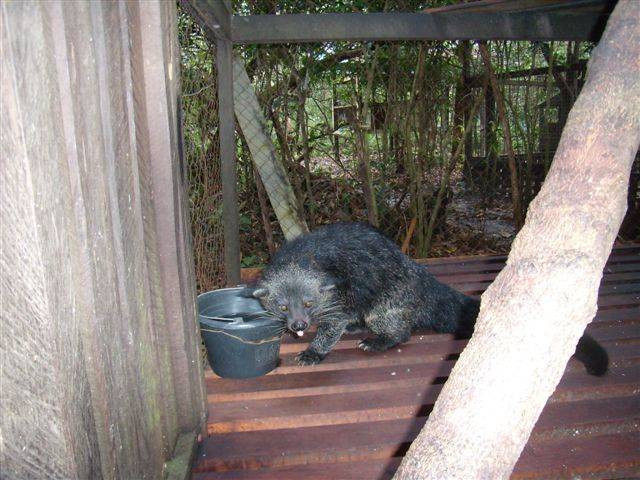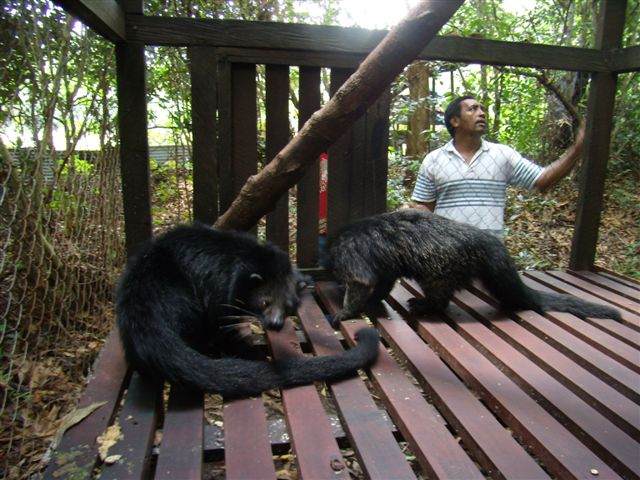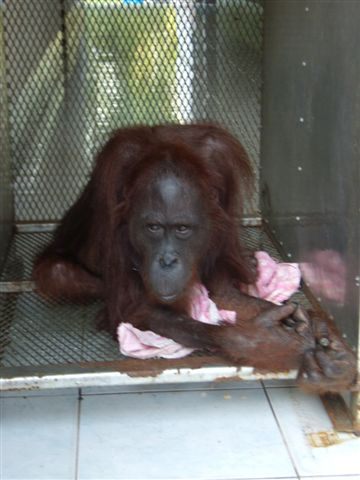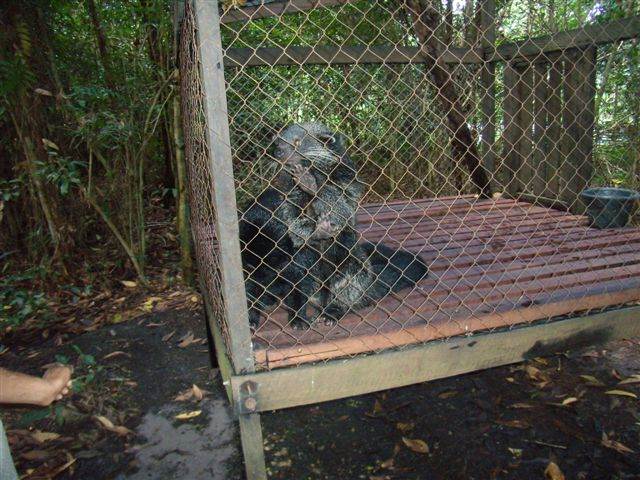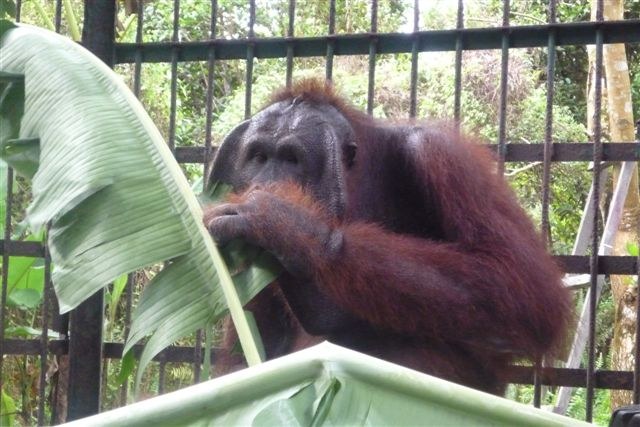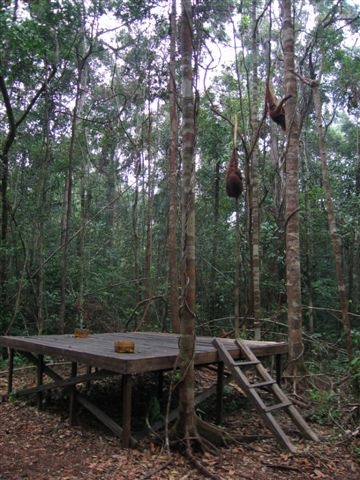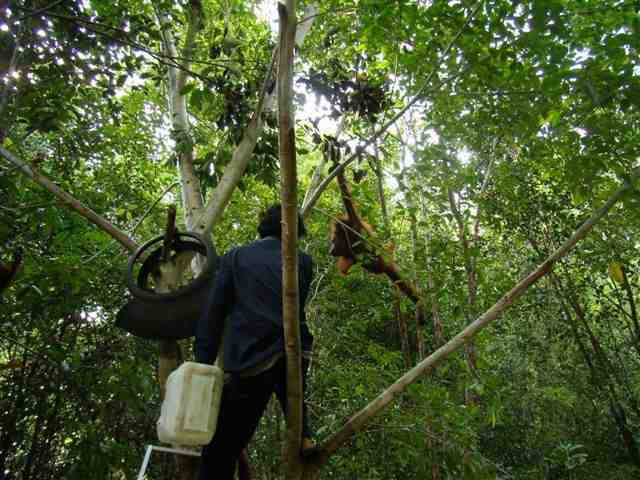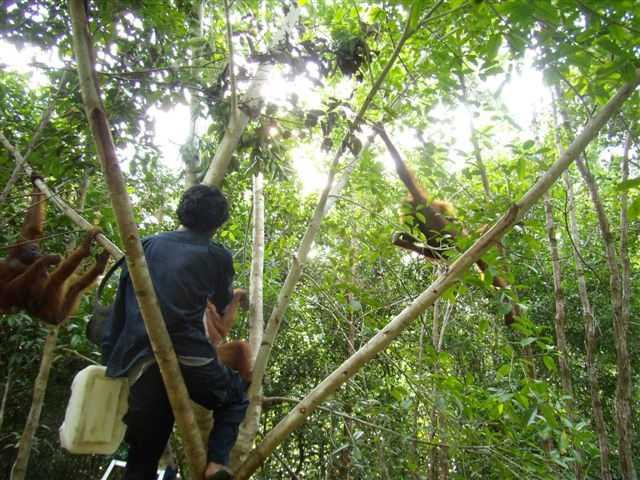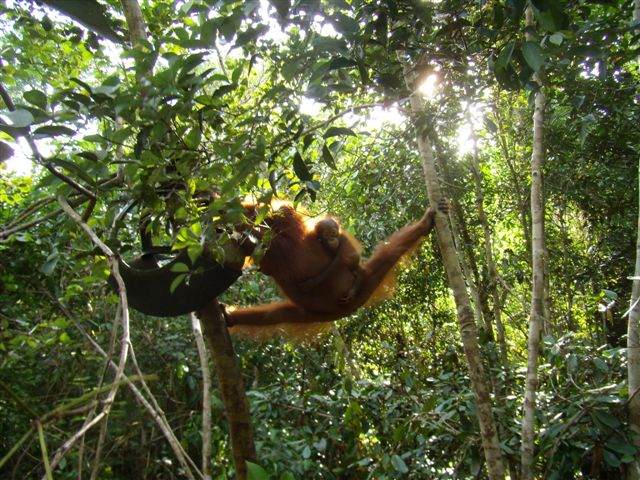Orangutan Making Good Recovery.
Thank you all very much for your kind and supportive comments on Zidane. Yesterday, I had to go out to the Care Centre again and so took the opportunity to look in on him. I couldn’t believe it – he wasn’t there!!! The vets said he had been so energtic in the morning, once his sleeping-cage door was opened he took his carers hand and wandered off into the nursery forest. Time was limited so I did not follow him out there. Clearly though he continues to go from strength to strength.
I did however pop over to see the binturongs.
They weren’t best pleased to be woken up in the middle of the day but did happily come down for a sniff around. I still think they are amazing. Scientifically, binturongs are classed as carnivores in the family viverrids, which includes civits and genet cats. It may be simpler for US readers to think of them as racoons with attidute or, for European readers, to imagine a badger with a prehensile (gripping) tail.
By the way, the man next to the binturongs’ cage is Mr Sehat, the senior assistant at the Care Centre. He is absolutely amazing with the orangutans and is, beyond all doubt, Montana’s best friend.
There have been a few comments asking about who shot Zidane. These are good questions and it is still being investigated so unfortunately I can't give you any more information at the moment.
Thanks again,
Stephen
Zindane: Orangutan Out Of Intensive Care
This blog was supposed to be about my most recent field trip. However, this afternoon I had to pop over to the Orangutan Care Centre & Quarantine so I thought I would give you a quick update on Zidane. Bottom line – he’s out of intensive care.
Zidane when he first arrived at the OCCQ -emaciated and very sick.
A few weeks later Zidane is now alert and looking better (apologies if the photos are blurry. I switched off the flash again).
He is looking much better. His eyes are fuller and brighter. You can tell he is much more alert and active. His carers say his appetite has picked up, though he remains reluctant to drink. Tigor has, as a result, been plying him with isotonic sports drinks which, at least, he seems to enjoy.
“There are many a slip twixt cup and lip” and he is certainly a long way from being ready to return to the forest. But, the fact he no longer needs 24 hour care is a positive sign. I am now cautiously hopeful Zidane will make a full recovery.
In the next day or so I’ll tell you about the field trip. Sheryl, thank you very much for your most recent donation and your continued support. Donations will go towards funding our new orangutan feeding system in Lamandau and a new solar power set for Pondok Ambung, our research station.
Thank you and best wishes,
Stephen
Orangutan still very sick but now eating.
I went out to the Care Centre today to check on Zidane. While still in a pretty awful state he is improving. We have brought one of the Camp Buluh staff back to town to sit with him throughout the day. He offers Zidane food whenever he feels like it. Zidane is eating but he is reluctant to drink. However, the affection he shows for people is touching. He actually slid off his makeshift cot for a hug. Thank you Brigitta for your generous donation of $100 it is very much appreciated by all of us.
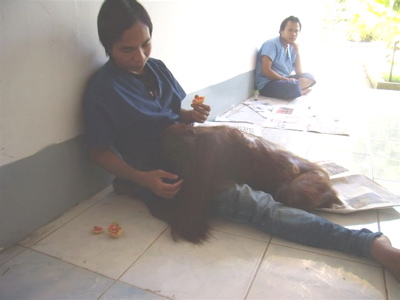
(Apologies if the photo is dark – I deliberately switched the flash off)
Elly, from the UK office, is visiting the field projects at the moment so she came to the Care Centre too.
Elly receiving an enthusiastic welcome.
There is a pair of binturongs (Arctictis binturong) also known as bearcats at the Centre at the moment.
They are very cool animals. It is a dream of mine to see one in the wild… as well as to Zidane back in the trees.
What do we do with banana trees?
Where did last week go? I spent most of it in Tanjung Puting National Park, having lots of fun and adventures, and only got back to the office on Friday. We are still experiencing lots of power cuts. On Saturday, we had a five hour one, 8 am to 1 pm, which put paid to much serious work. So here I am, Sunday night, attempting to tell you how I spent my week, obviously, without much internet!I went first to Buluh Besar Guard Post in the middle of the Park, and from there, to Pondok Ambung and Camp Leakey, where I met up with Brigitta. However, this all deserves its own post (to come soon), so I will just cut to today. My back garden has been as over-productive as usual and the latest banana tree, to try to outgrow the electrical wire to my water-pump, needed felling. What do we do with banana trees? Give them to Montana.
Montana with his banana tree.
I went to the Orangutan Care Centre & Quarantine with a group of visiting researchers and found the big guy looking unusually bored. He was laid flat out with his massive head resting on his two fists. He didn’t even turn his head as we approached. Once the banana tree was near enough to be on offer, however, he sprang into action in a way that reminded me – yet again – never get too close: He’s quick! The stalk was inside in seconds, and then the leaves. And Montana was one happy orangutan.
Less pleased were the adolescents occupying the next-door enclosure, who wouldn’t normally dare so much as whimper at the adjacent cheek-padded Montana. Today, though, they were happy to demand attention from the visitors. We gave them extra leaves and they were delighted. I even managed to get a smile from one of them (unlike young chimpanzees that will literally giggle if tickled, orangutans seldom express pleasure), getting a full toothy grin was reward in itself.
Me with the adolescents.
Thanks for your comments, Sheryl and Annie, about the paper (which we contributed to) mentioned in my last post, “Distribution and conservation status of the orangutan (Pongo spp.) on Borneo and Sumatra: How many remain?”. I agree, it is important to think positively and I don’t believe orangutans will become extinct. I think the programmes that we, and our partners, are working on in Central Kalimantan, will ensure this never occurs.
Feeding orangutans - a new approach
“Why do you do it like that?” “That’s the way it has always been done.”
One of the standards in orangutan rehabilitation is released orangutans are fed on a platform.
Photos showing the feeding platforms that have always been used.
Everyone does it; as do we. But then we got to thinking there has to be a better way. Wild orangutans, especially in Borneo, rarely if ever, feed in groups. So why should ex-captives?
Without the platform though, how do you feed them? By hand is not an option. So we thought “put a bucket on a tree”. No, the orangutans will destroy a bucket in seconds. OK, use a cooking pot. Imagine the noise they would make banging that around, plus they will rip it off the tree! Alright then, use an inside out car tyre as a bucket. Fine, but how are you going to attach it; we don’t want to bore into the tree? Here’s an idea, when you cut off the side walls to invert the tyre, use the off-cuts as straps to hold the tyre against the tree.
Old tyres- they have many uses, if not for fire beaters then as a feeding bucket
So we’re settled: the food goes in the car tyre strapped to the tree. But how do you give them their milk (which many love more than fruit)? Cups – they’ll break, be lost and will become litter. Water bottles – even worse. Let’s try coconuts. Cut the top off, pour the milk in, put the coconut in the tyre; if the orangutans drop it, it will be easy to find and even if we don’t it is hardly litter.
All good then - let’s try it.
Its a good job our assistants are tree climbers too!
The feeding system has been running in Camp Siswoyo for a month now. It is not perfect. More than one orangutan may descend on each tyre. Some still walk on the ground between the feeding trees. We are buying an awful lot of coconuts – the orangutans drink the milk then eat the nut! It is more work on the staff and they have to be quick to get the food out.
But is it better than the platforms? Oh yes. You can ensure a fairer distribution of food. It lessens competition, facilitates giving medication when necessary and it keeps the orangutans feeding in the trees.
The system needs to be tweaked, but as a first attempt at a new idea we are all delighted with the result. And here’s where I have to add a thank you not only to Tigor and his staff for their enthusiasm to give it a go, but also to Jodie and Peter: the endless night’s talking about how we could make individual feedings work were worth it!
"We are participating in WildlifeDirect's business strategy. Please help us by taking this user survey,
thank you"




